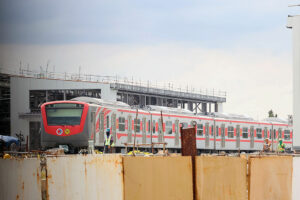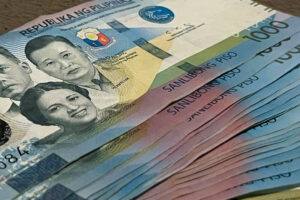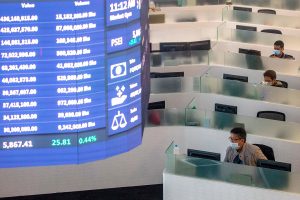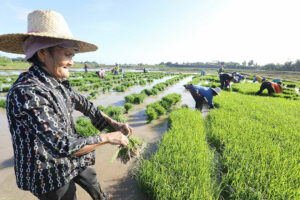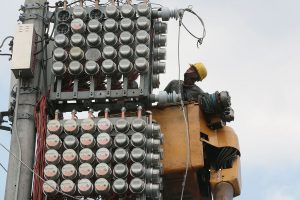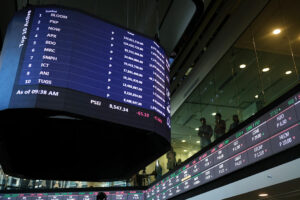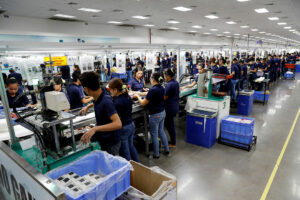The Philippines’ unemployment rate rose to a three-year high of 5.3% in July as a series of typhoons and monsoon rains dented hiring activity, the statistics agency said on Wednesday.
The number of jobless Filipinos increased to 2.59 million in July from 2.38 million a year prior and 1.95 million in June, preliminary data from the Philippine Statistics Authority’s (PSA) labor force survey showed.
The 5.3% unemployment rate was the highest in three years or since the 6% in June 2022, which had reflected the impact of the pandemic lockdowns. It also matched the jobless rate seen in August 2022.

The July rate was also higher than the 4.7% recorded in the same month in 2024 and the 3.7% in June 2025.
On average, the jobless rate for 2025 thus far is at 4.1%, a tad higher compared to the 4% in the comparable year-ago period.
National Statistician Claire Dennis S. Mapa said the jobless rate went up in July due to the impact of four typhoons and the southwest monsoon on the agricultural sector.
The Philippines experiences more tropical cyclones than any other region in the world, averaging about 20 each year. Typhoon activity is most intense from July to October, when nearly 70% of all cyclones develop, according to the country’s official weather bureau.
The agricultural sector (skilled agricultural, forestry, and fishery workers) lost 974,000 jobs year on year. In terms of major industries, the agriculture and forestry sectors lost 1.38 million.
“The agriculture sector is the contributor to the spike in unemployment due to the adverse weather conditions and multiple tropical depressions last July. I cannot predict if this is just a one-time occurrence as there are still projections of weather disturbances this year,” Labor Secretary Bienvenido E. Laguesma told BusinessWorld via Viber.
The agriculture subsectors that mainly contributed to the year-on-year decline in jobs were the cultivation of paddy rice (-750,000) and corn (-456,000), Mr. Mapa said.
“We’ve already seen this since January — that there has really been a decline in employment in rice. So, maybe there are several factors affecting this [like] the weather, and some are saying it’s also because of the low farmgate price of palay,” he said in Filipino during a press briefing. “For corn growing, there was also a decrease of 456,000. In hog farming, there was a decrease of 133,000, again because some provinces were affected by the ASF (African Swine Fever).”
“We are seeing that there are subsectors that are significantly affected by the weather. In the month of July, we were hit by four typhoons, which affected a substantial number of provinces and had an impact on our labor market,” Mr. Mapa added.
In a separate statement, the Department of Economy, Planning, and Development (DEPDev) urged stronger efforts to boost climate resilience and workforce agility.
DEPDev Secretary Arsenio M. Balisacan called for modernized agricultural practices, climate-smart strategies, rural infrastructure, and digital connectivity to help cushion the impact of extreme weather events on jobs.

“The latest employment figures underscore the urgency of modernizing our economic sectors to withstand disruptions, whether from climate change or technological shifts. We are also fully committed to enhancing employability, expanding labor market programs, and collaborating with key stakeholders to future-proof the Filipino workforce,” Mr. Balisacan said.
University of the Philippines School of Labor and Industrial Relations Assistant Professor Benjamin B. Velasco said job losses in the agriculture sector due to climate hazards could continue in the coming months.
“Definitely, the job hemorrhage in agriculture was a climate change effect, which unfortunately will not be a one-off phenomenon, but [will] even worsen until the end of [the] rainy season, which now extends to November,” he said via Facebook Messenger.
“The long-run trend is for agriculture employment to decrease and waged jobs in rural areas to increase due to [the] impact of trade liberalization as well as commercialization and industrialization, though limited and erratic,” he added.
Meanwhile, the wholesale and retail trade, repair of motor vehicles and motorcycles sector shed 897,000 workers in July from the same month last year, while fishing and aquaculture lost 173,000.
Mr. Mapa said agricultural workers who lost jobs due to bad weather transferred to the construction industry.
Despite the increase in the jobless rate in July, he expressed optimism that employment will increase as the holiday season approaches, as seen in historical trends.
Mr. Laguesma likewise said, “the coming holiday season will result in [a] higher employment rate.”
Underemployment rate up
Meanwhile, PSA data also showed that the underemployment rate rose to 14.8% in July from 12.1% in the same month a year ago and 11.4% in June.
The ranks of underemployed Filipinos — those who want longer work hours or an additional job — reached 6.8 million in July, higher than the 5.77 million a year ago.
For the first seven months, the average underemployment rate stood at 12.9%, higher than 12.2% in the same period last year.
The labor force participation rate also fell to 60.7% in July from 63.5% a year prior. Mr. Mapa likewise attributed this to the bad weather during the month, identifying the agriculture, construction and manufacturing sectors as the areas with the largest drops.
Some 94.7% or 46.05 million Filipinos had jobs in July, lower than the 95.3% or 47.68 million recorded a year prior.
For the seven months ended July, the employment rate stood averaged 95.9%, lower than 96% last year.
Meanwhile, by worker classification, wage and salary earners made up the majority of employed persons at 68.7% in July. They were followed by the self-employed without paid employees at 24.7%, unpaid family workers at 3.9%, and employers in their own family-run farms or businesses at 2.6%.
Within the group of wage and salary workers, those in private establishments continued to represent the largest share at 78.5%, equivalent to 53.9% of the total employed population. Those working in government or government-controlled corporations accounted for 14.4% of wage and salary workers, or 9.9% of the overall employed persons.
By region, the Cordillera Administrative Region posted the highest employment rate in July at 96.6%, while the Bicol Region (Region V) recorded the lowest at 92.3%.
Eight regions registered unemployment rates above the national average of 5.3%, led by the Bicol Region at 7.7%, followed by Region IV-A (Calabarzon) with 6.6% and Region VII (Central Visayas) with 6.1%.
Labor groups said the rise in unemployment highlights the need for a legislated wage hike to strengthen the purchasing power of workers.
“The spike in unemployment is alarming, and the rise in underemployment tells us that even those who have jobs are not earning enough to live decently,” Federation of Free Workers President Jose Sonny G. Matula told BusinessWorld via Viber.
He said the latest figures mirror the worsening jobs and wages crisis in the country, aggravated by inflation, the persistence of precarious work, and the lack of sustainable and quality employment opportunities.
The Sentro ng Mga Nagkakaisa at Progresibong Manggagawa said in a separate statement that the data show that the government’s job creation efforts are lacking.
“The truth is out: millions of Filipinos remain stuck in insecure, low-quality, and low-paying work,” it said.
“While other countries are advancing in manufacturing, industry, and innovation, the Philippines is trapped in informality and precarity — a failure in part of our administration… Every month these employment figures stay the same means another month when millions of Filipinos are condemned to poverty and indignity.” — Chloe Mari A. Hufana, Reporter







 DOWNLOAD
DOWNLOAD




